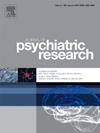System-based pain groups are uniquely associated with sociodemographic and psychiatric correlates among those with posttraumatic stress disorder (PTSD)
IF 3.7
2区 医学
Q1 PSYCHIATRY
引用次数: 0
Abstract
Objective
Chronic pain is a prevalent comorbidity among those with posttraumatic stress disorder (PTSD). Chronic pain can be divided into specific pain (i.e., involving a single body system) and complex pain (i.e., involving multiple body systems). We explored sociodemographic and psychiatric differences between pain groups among those with PTSD.
Method
Data came from the National Epidemiologic Survey on Alcohol and Related Conditions (NESARC-III, N = 36,309). Pain groups were determined through health professional confirmed self-report of chronic pain conditions within three body systems (musculoskeletal, nerve or digestive conditions). Psychiatric conditions were identified with the Alcohol Use Disorder and Associated Disabilities Interview Schedule for DSM-5; suicide attempts were assessed via self-report.
Results
Among our PTSD sub-sample (n = 1779; 4.7%), 53.9% had no conditions, 25.6% endorsed specific pain, and 19.1% endorsed complex pain. Multinomial logistic regressions revealed increased odds of certain sociodemographic correlates (e.g., older age) common to both pain groups when compared to those with PTSD alone, as well as decreased odds (e.g., being non-White) unique to those with complex pain. Multivariable logistic regressions revealed both specific pain and complex pain were associated with increased odds of any lifetime personality disorder relative to the no pain group (AOR = 1.56 and 2.38, respectively). Complex pain was uniquely associated with increased odds of any past-year anxiety disorder, past-year tobacco use disorder, and lifetime suicide attempts (AOR range = 1.46–1.69) relative to PTSD alone.
Conclusion
Findings indicate that those with PTSD and pain conditions impacting multiple body systems represent a particularly vulnerable group.
求助全文
约1分钟内获得全文
求助全文
来源期刊

Journal of psychiatric research
医学-精神病学
CiteScore
7.30
自引率
2.10%
发文量
622
审稿时长
130 days
期刊介绍:
Founded in 1961 to report on the latest work in psychiatry and cognate disciplines, the Journal of Psychiatric Research is dedicated to innovative and timely studies of four important areas of research:
(1) clinical studies of all disciplines relating to psychiatric illness, as well as normal human behaviour, including biochemical, physiological, genetic, environmental, social, psychological and epidemiological factors;
(2) basic studies pertaining to psychiatry in such fields as neuropsychopharmacology, neuroendocrinology, electrophysiology, genetics, experimental psychology and epidemiology;
(3) the growing application of clinical laboratory techniques in psychiatry, including imagery and spectroscopy of the brain, molecular biology and computer sciences;
 求助内容:
求助内容: 应助结果提醒方式:
应助结果提醒方式:


